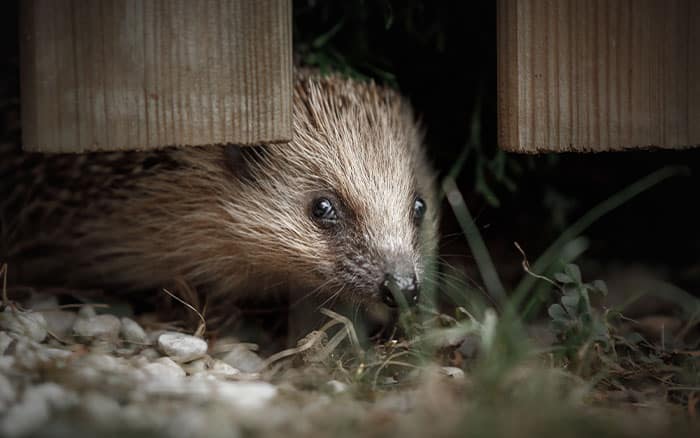As much as you enjoy your garden and the produce that you grow, there are plenty of other creatures who enjoy visiting it too. Due to habitat loss in the UK, there has been a decline in British wildlife. Therefore, we must do our best to keep our gardens accessible and safe to nurture local wildlife.
Help the Hedgehogs
Hedgehogs are known to hibernate between November and March, there may still be spiky visitors in your garden this October through to parts of November. These are juvenile hedgehogs and will need help to survive the winter months. Autumn juvenile hedgehogs are old enough to be away from their mothers but too small to hibernate successfully. So, they need to build up their fat reserves for winter.

Help them to get the nourishment they need by providing water and cat or dog food that is either chicken or turkey in jelly.
Try to avoid food with gravy, as this can be too salty.
Be sure to keep an eye on your visitors. If it is a regular at night-time and are making the most of your hospitality, it can be left in the wild.
To help the hedgehogs roam freely, cut a 13x13cm hole in your fence and encourage neighbours to do the same.
This creates a hedgehog home to attract the gardener’s best friend, which will see them continue to come back for more and more.
Berries for Birds
Top up your bird feeders and ensure the bird bath is still ready for visitors. There are many birds to look out for in the winter months.
For some people, robins are the epitome of winter, signifying the festive time that’s on its way. Robins are one of the few birds that continue to sing through the winter months. Also, they are likely to be the first heard at dawn and the last to stop singing at night. In the winter they switch their diet from insects and worms to fruit.
Another winter visitor is the Redwing, migrating to the UK from northern Europe, Iceland, and Russia. They come to the UK on the lookout for berries and fruit, including hawthorn and holly berries as well as fruit from Pyracantha.
Although it’s wonderful to see our flying friends in our garden, we still want them to leave some of the grub to us.
For that reason, creating barriers with netting will keep birds out, but be sure to plant berry-fruiting trees and leave them a bird feeder full of seeds or fat balls for them to feast on instead.
If using nets, please be mindful of hedgehogs, so keep them clear of the ground to be safe.

Plants for Pollinators
It’s estimated that one-third of food is pollination-dependent, and bees are one of the most common pollinators we see in our gardens. Bees help by pollinating many of our fruit and veg crops including broccoli, squash, cucumbers, cabbages, and apples.
As a result of milder winters and more winter-flowering plants, there has been a boost in winter-active pollinators such as the buff-tailed bumblebee. It’s thought that winter-active pollinators can be more successful when foraging compared to summer pollinators. This is because there are fewer competitors.

There are plenty of plants to invite bees in over the winter period including Erysimum (wallflower) ‘Bowles’s Mauve’. This is an evergreen with a long flowering season when positioned in a sunny but sheltered spot with well-drained soil.
Fatsia japonica (Japanese aralia) is another evergreen, with clusters of cream flowers that will see winter pollinators visit.
Adding plenty of blooms to your garden, and providing accessible flowers to bees and other pollinators all year round will attract them to your space.
This will benefit your vegetable garden. Interplanting with flowers and herbs that are colourful and appealing to pollinators will also make your veg garden look marvellous.
Composting Critters
There’s a huge number of critters working hard in your garden that you don’t see every day. But by providing them with shelter and food, they’ll give plenty of goodness back.
Composting improves the biodiversity in the garden by utilising worms, fungi, bacteria, and insects to break down waste. And these beneficial bugs also make your garden less likely to be wiped out by pests and weeds because the soil is healthier.
As winter creeps closer, the temperature of your compost heap will start to decrease but giving it a turn will help to produce more heat.
To save the heap from going soggy, cover open compost heaps with some insulating board or black plastic. This will help keep the bin drier and keep the microbes active.
By keeping your compost heap active and working, albeit slowly, your veg patch will be thriving.
And you can use your quality homemade organic matter on your crops as a soil improver for planting out fruit and veg.
This is ideal for before the growing season and mulching in winter and spring.

By planting a wide variety of plants with fruits, flowers, and foliage for wildlife to enjoy in winter, you will be helping to keep the creatures thriving. Whilst your garden provides wildlife with water, nutrition, and shelter, they will thank you by pollinating your plants, preying on pests, and creating good-quality organic matter.

Leave A Comment